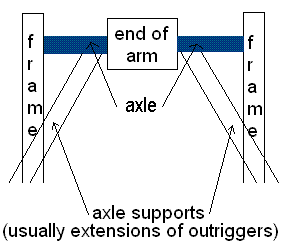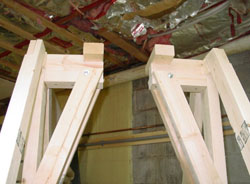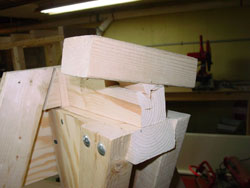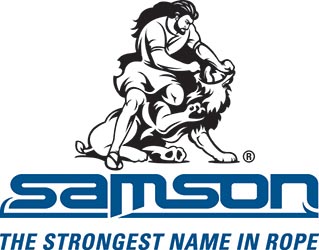Jeckyl and Hyde

Jeckyl and Hyde was designed in late 2006 and built in January/February 2007. This trebuchet was designed initially to be a King Arthur-style trebuchet. However, after watching some of the videos from the Fall 2006 Burlington Pitch, particularly those of UFO, then the largest whipper in the world, the plans were slightly modified so that the machine could be fired in both configurations with only a minor setup change. All this really entailed was extending the short arms a bit to facilitate easier triggering.
We did change the design of the frame from the Melon Felon and Tennis Ball Trebuchets when designing Jeckyl and Hyde, however. We wanted to narrow the span that the main axle has to span, which stands at 20" on the Melon Felon, and made axle selection a little tricky. Narrowing the span can be done in several different ways. One is to add many supports to the side of the arm around the axle to make it very wide, this reduces the stress on the axle as well as anything else. However, this adds considerable mass to the arm, especially when you are talking about an arm as light as the one for Jeckyl and Hyde (it only weighs a few pounds on its own!) So, this was not the solution for us. Another way, and one that is probably the most common, is to extend the side supports of the trebuchet inside the frame, up to the main axle, where it can support the axle near the arm. This also creates far less stress on the main axle while still allowing room for a wide counterweight. The general idea looks something like this:

However, this creates another issue. The use of bearings on the main axle is always a good idea, as it allows the arm to rotate easier, increasing the launch velocity of the projectile, thus yielding an increased range. Extending the frame inward like this increases friction on the axle, making the use of bearings almost pointless. So, we decided to figure out a way to mount the bearings right on the axle supports themselves. A few hours of calculations later, and we had figured out a way to make it work. By adding more material to the area where the axle, frame, and axle support triangle area is in the figure above, the supports were adequately supported, and we could mount our bearings on the supports, meaning that the axle only had to span roughly 7 inches, most of which would be taken up by the arm anyway.

One of these bearing mounts was to fail on an initial test shot in February 2007, however, prompting further reinforcement of the mounts before our first major testing on March 30, 2007.

With the decision to use a counterweight up to 100 pounds in weight, and to make use of the axles from the Melon Felon, this meant that the only cost for this trebuchet was going to be the wood to build with and the various hardware needed for operation. As such, it was hoped to keep total costs for Jeckyl and Hyde under $50, and we actually came in around $40 for the initial build.









